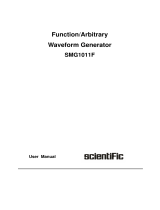
July 2016
0TABLE OF CONTENTS
1 INTRODUCTION.....................................................................................1
1.1 Description .................................................................................. 1
1.2
Main Features .............................................................................. 1
2 GETTING STARTED ................................................................................2
2.1
Front Panel .................................................................................. 2
2.2
Rear Panel................................................................................... 4
2.3
Display........................................................................................ 5
2.4
General Inspection........................................................................ 6
2.4.1
AC Power Input Setting.............................................................. 6
2.4.2
Power On................................................................................. 7
3 PANEL OPERATION................................................................................8
3.1
To set channels ............................................................................ 8
3.2
To set signals............................................................................... 9
3.2.1
To Output Sine Signals .............................................................. 9
3.2.2 To Output Square Signals ........................................................ 11
3.2.3 To Output Ramp Signals .......................................................... 13
3.2.4 To Output Pulse Signals ........................................................... 15
3.2.5 To Output Noise Signals........................................................... 17
3.2.6 To Output Arbitrary Signals ...................................................... 17
3.2.7 To Output DC ......................................................................... 22
3.2.8 To recall wave file ................................................................... 22
3.3 To Generate the Modulated Waveform ........................................... 25
3.3.1 AM (Amplitude Modulation) ...................................................... 25
3.3.2 FM (Frequency Modulation)
...................................................... 26
3.3.3 PM (Phase Modulation)
............................................................ 28
3.3.4 FSK (Frequency Shift Keying) ................................................... 29
3.4 To Generate Sweep..................................................................... 31
3.5 To Generate Burst ...................................................................... 32
3.6 To Save and Recall ..................................................................... 35
3.7 To Set the Utility Function............................................................ 37
3.7.1 To Set Display Parameter......................................................... 37
3.7.2 To Set the Counter.................................................................. 38
3.7.3 To Set Output Parameter ......................................................... 39
3.7.4 To Set the System .................................................................. 40
3.8 To Use Built-in Help .................................................................... 42
4 COMMUNICATION WITH PC
............................................................43
5 SCPI ....................................................................................................44
6 TROUBLESHOOTING ............................................................................45
7 INSTRUCTIONS FOR RETUR
NING BY MAIL ..........................................46
8 TECHNICAL SPECIFICATIONS..............................................................47























